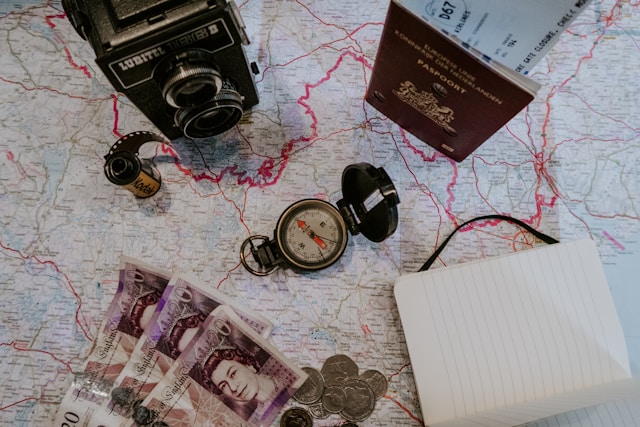Planning a trip is exciting, but one of the biggest questions travelers face is: how much will it cost? Creating a realistic travel budget breakdown is essential for making sure your adventure is both enjoyable and financially stress-free. From flights and accommodation to food and hidden costs, knowing what to expect helps you avoid surprises and make the most of your vacation.
In this guide, we’ll walk through the core travel expenses, show you sample budget ranges, and share tips to keep costs under control no matter your travel style.
Major Travel Expenses
When mapping out the cost of travel, it helps to break things down into categories. Here are the most common travel expenses you should include in your budget:
1. Flights and Long-Distance Transportation
Airfare is often the biggest line item in a travel budget. Prices vary depending on the destination, season, and booking time. A round-trip flight within the U.S. might cost $200–$400, while international flights can range from $600 to $1,500 or more. Trains, long-distance buses, or rental cars are alternatives to consider, especially in regions like Europe or Southeast Asia.
2. Accommodation
Where you stay greatly affects your overall travel budget. Options range from $20 per night hostels for budget travelers to $80–$150 mid-range hotels and $250+ for luxury stays. Airbnb and guesthouses often fall in the mid-range category but can sometimes be cheaper depending on location.
3. Food and Drinks
Eating habits make a huge difference in vacation expenses. Street food or casual cafes can cost $5–$15 per meal, while sit-down restaurants often range from $20–$50 per person. If you’re staying somewhere with a kitchen, cooking a few meals is a great way to lower the average travel costs per day.
4. Activities and Entertainment
This includes tours, excursions, entrance fees, and entertainment. A museum ticket might cost $10–$20, while guided tours can range from $50 to $150. For adventure activities like scuba diving, skiing, or safaris, expect significantly higher prices.
5. Local Transportation
Getting around once you arrive also adds up. Subways and buses are usually the cheapest option at $1–$5 per ride. Ride-hailing apps, taxis, or scooters can cost more depending on the city. In some destinations, renting a bike or using local trains is both affordable and convenient.
6. Miscellaneous Costs
Don’t forget extras such as travel insurance, visas, SIM cards, shopping, tips, and emergency funds. Travel insurance can be $50–$100 for a two-week trip, while visas range from $25 to $150 depending on the country.
Sample Budget Breakdown
Here’s what a daily travel budget might look like, depending on your style:
-
Budget Traveler (backpacker style): $40–$70 per day
-
Hostel dorm: $20–$30
-
Street food/local cafes: $10–$20
-
Public transport: $5–$10
-
Activities: $10–$20
-
-
Mid-Range Traveler: $100–$200 per day
-
Hotel/Airbnb: $70–$120
-
Restaurants: $30–$50
-
Local transport + occasional taxi: $10–$20
-
Activities: $30–$50
-
-
Luxury Traveler: $300+ per day
-
Luxury hotel or resort: $250+
-
Fine dining: $70–$150
-
Private transport: $30–$60
-
Activities and excursions: $100+
-
Factors That Influence Travel Costs
Your travel budget breakdown will look very different depending on a few key factors:
-
Destination: Europe and North America tend to have higher average travel costs than Southeast Asia or South America.
-
Travel style: Backpackers spend less by choosing hostels and street food, while luxury travelers spend significantly more.
-
Seasonality: Peak season (summer, holidays) means higher flight and hotel prices. Off-season can save you up to 30–50%.
-
Trip length: The longer you stay, the more daily expenses add up, but you may save on flights if you’re traveling long-term.
Budget Travel Tips
If you’re worried about vacation expenses spiraling out of control, here are some tips to stretch your money:
-
Book flights early and use fare comparison tools to find deals.
-
Travel in the off-season for lower airfare and accommodation prices.
-
Use public transport instead of taxis whenever possible.
-
Mix splurges with savings splurge on one big experience, then balance with cheaper meals or free activities.
-
Track your travel expenses daily with budgeting apps to stay on top of spending.
Conclusion
A clear travel budget breakdown is the difference between a trip filled with stress and one filled with unforgettable memories. By planning for flights, accommodation, food, entertainment, and hidden costs, you’ll know exactly what to expect. Whether you’re a budget traveler, mid-range explorer, or luxury vacationer, the key is to set realistic expectations and adjust based on your destination and style.

